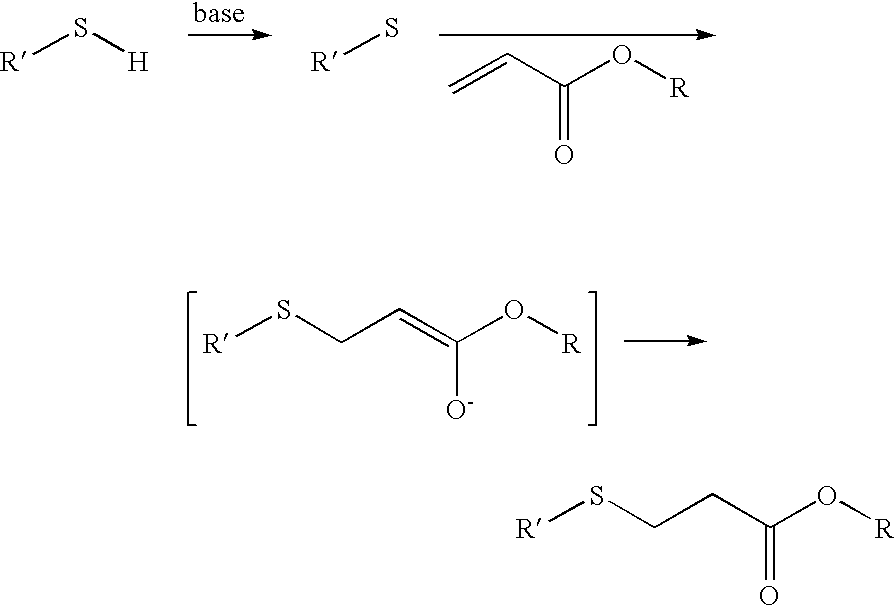Method for sterilization using in situ gelling materials
a gelling material and in situ technology, applied in the field of permanent contraception, can solve the problems of high financial cost, high risks of this kind of procedure, and economic inaccessibility to a significant part of the population
- Summary
- Abstract
- Description
- Claims
- Application Information
AI Technical Summary
Benefits of technology
Problems solved by technology
Method used
Image
Examples
example 1
Synthesis of poly(ethylene glycol) hexathiol (PEGHT)
[0048] The QT (8.58 g, 17.5 mmol) was combined with 8 mL H2O and 2 mL 1N NaOH in 100 mL of tetrahydrofuran (THF). The PEGDA 570 (1 g, 1.75 mmol) was combined with 1 mg of 2,6-di-tertbutyl-p-chresol (radical inhibitor) in 10 mL di-chloromethane (DCM). The PEGDA solution was then diluted with 15 mL of THF. The diluted PEG solution was then dropwise added to the stirred QT solution. After 55 min the pH was adjusted to 7 using glacial acetic acid. To remove water, the solvent was evaporated and the product was redissolved in 100 mL of toluene. The toluene was evaporated and an additional 100 mL of toluene was added. About 13 g of sodium sulfate was added, and then the sodium sulfate was removed by filtering. Before precipitation in 10-fold excess diethyl ether, the solution was concentrated by evaporating some of the toluene. The diethyl ether was decanted and the liquid product was recovered. The product was dried under vacuum.
1H-NM...
example 2
Synthesis of poly(ethylene glycol) tetraacrylate (PEGOA)
[0049] The PEGDA 570 (20 g, 35 mmol) was combined with 20 mg of 2,6-di-tertbutyl-p-chresol in 10 mL DCM. This was then diluted with 90 mL THF. The NaOH (3 mL, 0.2N) and 1 mL of H2O were added. The QT (1 g, 2.0 mmol) was dissolved in 40 mL of THF. The QT solution was added dropwise to the stirred PEGDA solution. After 30 min, 7 μL of glacial acetic acid was added to neutralize the reaction. The solvent was evaporated and 100 mL of toluene were added. After drying over sodium sulfate, the solution was filtered, concentrated and then precipitated using 10-fold excess diethyl ether. After precipitation the product was dried under vacuum.
1H-NMR (CDCl3): δ=6.4 (dd, 4H, CH2=CHCOO), 6.15 (dd, 4H, CH2=CHCOO trans), 5.85 (dd, 4H, CH2=CHCOO cis), 4.25 (t, 2H -OCH2CH2OOC—), 3.6-3.7 (40+16H, CH2CH2O and C(═O)OCH2C(CH2—)3), 2.8 (m, 8H, SCH2CH2COO), 2.65 (m, 8H, SCH2CH2COO) ppm.
GPC: Mn=2600; Mw=2900 (THF, PEG standards)
example 3
Preparation of Crosslinked Biomaterials
[0050] Crosslinked materials were prepared as dispersions or reverse emulsions of precursors in modified phosphate buffered saline (PBS). The PBS, 10 mM solution, was obtained by mixing equal volumes of 10 mM PBS adjusted to pH 9 with the addition of triethanolamine or 1N NaOH, respectively.
PUM
| Property | Measurement | Unit |
|---|---|---|
| temperature | aaaaa | aaaaa |
| pH | aaaaa | aaaaa |
| pH | aaaaa | aaaaa |
Abstract
Description
Claims
Application Information
 Login to View More
Login to View More - R&D
- Intellectual Property
- Life Sciences
- Materials
- Tech Scout
- Unparalleled Data Quality
- Higher Quality Content
- 60% Fewer Hallucinations
Browse by: Latest US Patents, China's latest patents, Technical Efficacy Thesaurus, Application Domain, Technology Topic, Popular Technical Reports.
© 2025 PatSnap. All rights reserved.Legal|Privacy policy|Modern Slavery Act Transparency Statement|Sitemap|About US| Contact US: help@patsnap.com



